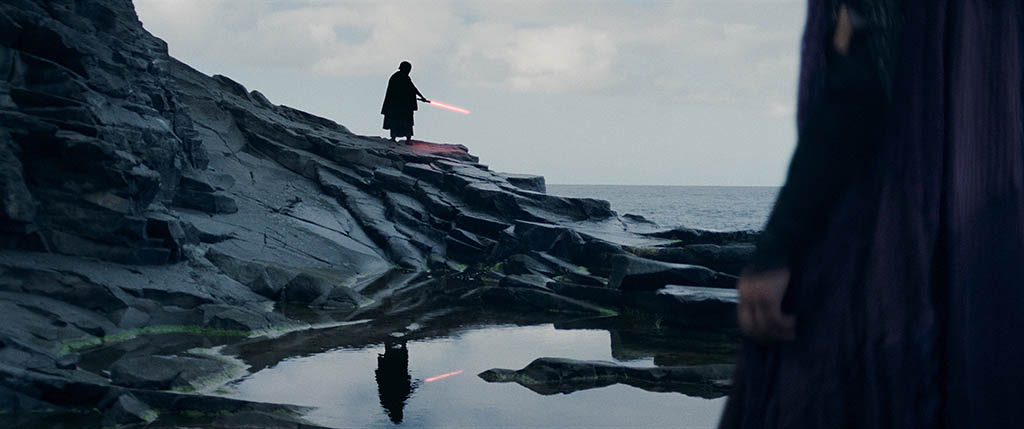
WWW.VFXVOICE.COM
LIGHTWHIPS, DAGGERS AND SPACESHIPS: REFRESHING THE STAR WARS UNIVERSE FOR THE ACOLYTE
By TREVOR HOGGImages courtesy of Lucasfilm Ltd. and Disney+.When Jedis associated with a tragic incident that took place in a witch coven situated on Brendock are assassinated, a Jedi Master is drawn into the mystery. When it is suggested that his former padawan is responsible for the killings, the Jedi Masters investigation uncovers a much larger Sith conspiracy. A force to be reckoned on the High Republic Era set of the The Acolyte, which occurs a century before the Star Wars prequel trilogy, is creator, executive producer, showrunner, director and writer Leslye Headland. Consisting of eight episodes, the Lucasfilm and Disney+ production has Julian Foddy moving from being a visual effects supervisor at ILM to working client side where he was responsible for digitally augmenting 2,800 shots.Ive done quite a lot of big Marvel films and various other Star Wars projects where they had a lot more reliance on CG content. [Director] Leslye Headland wanted to try to keep everything real and practical. The mantra was, What would have George Lucas done when he was making the original trilogy? Creatures and sets should be real. I had to approach the project with the view to minimizing the number of visual effects in most shots.Julian Foddy, Production Visual Effects SupervisorApproximately 2,800 visual effects shots were produced for the eight episodes by ILM, Rising Sun Pictures, Luma Pictures, Hybride, beloFX and Outpost VFX, with previs created by Proof.This is the first show that Ive done where I was the overall Production Visual Effects Supervisor, so straight away it was a different experience, Foddy states. Ive spent a lot of time on set for various projects before but have never been involved quite as early as I was on The Acolyte. As the Production Visual Effects Supervisor, youre onboard from day one, so I was party to original drafts of scripts and had a creative voice throughout all of the prep. That was fantastic, and Im keen to stay in a production role.The forest world of Khofar, where the Wookiee Jedi Master Kelnacca lives in isolation, is introduced in The Acolyte.Amandla Stenberg plays twin sisters Mae and Osha Aniseya, and Lee Jung-jae portrays Jedi Master Sol Mogra under the direction of Leslye Headland.Extensive work was done by beloFX to achieve the proper mood and lighting for shots.Other differences were prevalent. It was a change from things Ive worked on over recent years. Ive done quite a lot of big Marvel films and various other Star Wars projects where they had a lot more reliance on CG content, Foddy notes. Leslye Headland wanted to try to keep everything real and practical. The mantra was, What would have George Lucas done when he was making the original trilogy? Creatures and sets should be real. I had to approach the project with the view to minimizing the number of visual effects in most shots. Despite the practical mantra, CG elements were unavoidable. One thing that is all CG are the ships with the exception of a shot where we used a miniature. Often, we had a practical ramp, or the inside of a compartment was a real set, but whenever you see the whole ship from the outside, whether its on the ground or out in space, those area always CG. The ships were designed by Kevin Jenkins [Production Designer] and the art department, and they always built physical models. Quite often, we had gray scale or balsawood models. We always had something there to visualize the form of the ship before getting it into CG; that allowed us to talk about things like the scale of the ship and what movement characteristics would they have when in space.One thing that is all CG are the ships with the exception of a shot where we used a miniature. Often, we had a practical ramp, or the inside of a compartment was a real set, but whenever you see the whole ship from the outside, whether its on the ground or out in space, those area always CG. The ships were designed by Kevin Jenkins [Production Designer] and the art department, and they always built physical models. Quite often, we had gray scale or balsawood models. We always had something there to visualize the form of the ship before getting it into CG.Julian Foddy, Production Visual Effects SupervisorThe mandate was to rely more on practical locations and sets, with beloFX doing some of the needed digital augmentation to the landscape and sky.CG also assisted in transitioning a signature pink Lightsaber from The High Republic novels into its cinematic counterpart. Full confession, declares Foddy. While all of the other Lightsabers do have tubes of LED lights, the Lightwhip itself did not have a practical component for safety reasons, as well as for technical and practical ones. The Lightwhip was something that Leslye desperately wanted to get into the show. I tasked the ILM art department with coming up with various concepts for how the Lightwhip might work and engaged in lengthy discussions with Pablo Hidalgo [a creative executive in story development at Lucasfilm] to make sure we got this right. Not only did we want to respect the fans of The High Republic novels but also discuss the technology of a Lightsaber and the physics of how the blade would work. We worked that out with Pablo to make sure that we did the whip so it felt plausible. We explored lots of different looks and pursued the idea that maybe the whip was made from small sections of a chain consisting of short Lightsaber blades or like a cat o nine tails that had more than one strand. Ultimately, we came down to the simplicity of the single strand. Its down to the nonchalance of how Vernestra Rwoh uses the whip as well. There is the touch of Indiana Jones in the way she flicks it. Leslye was keen to make sure we see that the Lightwhip is not only the badass weapon, but that Vernestra looks like a total badass when she uses it. It is a normal Lightsaber and has been modified to turn into the whip. There is an instance when Vernestra deploys or retracts the whip, and it snaps into a straight blade before returning into the hilt.Bluescreen was unavoidable but not heavily relied upon by the production.Martial arts and ninja tactics such as throwing daggers were incorporated into the lightsaber fight choreography. Wherever we could do it for real. we did it for real, Foddy explains. Obviously, you cant throw real knives, but we did have rubber-bladed ones that could be thrown; however, that is still dangerous. In Episode 101, when Mae [Amandla Stenberg] is fighting Indara Force [Carrie-Ann Moss], who snatches the knives from her that was a mixture of cunning switcheroos on the day [of shooting]. Amandla Stenberg would hold the knives in position, wed cut the camera, shed drop the knives, then we would run the camera again. There are some CG knives in the instances where theyre thrown or when Indara Force pulls them out of Maes belt. Most of the shots where you see Mae flipping the knives into her hands, thats all real. Amandla learned all of the knife skills and the manual dexterity to do those things, like twirling the knives from her palm into her grasp.For safety and logistical reasons, the daggers thrown by Mae were digitally added.Practical LEDs were used for the Lightsabers to get the correct interactive light, except for the Lightwhip.The architecture and spaceships of the High Republic are not significantly different from what are seen in the prequel trilogy, which occurs 100 later, as technology evolves slowly in the Star Wars universe.Anything that the cast would have to interact with was physically constructed and the rest extended in CG.A simple design language was utilized for the UI.Coruscant of the High Republic Era had fewer levels than what was seen in the prequel trilogy.Elements like hyper drives were treated as heavy bulk attachments for the spacecraft.The Trade Federation Fallon freighter ship is brought to life by ILM.Full confession. While all of the other Lightsabers do have tubes of LED lights, the Lightwhip itself did not have a practical component for safety reasons, as well as for technical and practical ones. The Lightwhip was something that [Director] Leslye [Headland] desperately wanted to get into the show. I tasked the ILM art department with coming up with various concepts for how the Lightwhip might work and engaged in lengthy discussions with Pablo Hidalgo [a creative executive in story development at Lucasfilm] to make sure we got this right.Julian Foddy, Production Visual Effects SupervisorTwins Leah and Lauren Brady were used for the scenes of Young Mae and Young Osha, while Amandla Stenberg portrays the adult versions of both sisters. You will see more of the adult twins together as the series progresses, Foddy reveals. It has been a mixed approach. Amandla had a performance-double named Shanice Archer, who was fantastic, and she spent several months in prep with a movement coach learning to adopt Amandlas physicality. All of the over the shoulders are Shanice. Quite a few shots have split screens. Also, we had quite a lot of involvement in the walk-throughs with the directors of photography and talked about how we could shoot scenes in a way that favored over the shoulders or seeing the two girls from behind. There are only very few instances where we had to worry about being able to do both of the twins faces. As well as split screens, we quite often shoot switcheroos as well, where I would literally have the girls swap places. In some cases, that gave us a facial element to put on the other actor who was done in the exactly same lighting conditions and camera position.A breakdown of a shot by ILM from plate to final compositing.Impacting the world-building was the time period of the High Republic. We are 100 years before the prequels. This is something we consulted with Pablo Hidalgo and Dave Filoni [CCO at Lucasfilm] about, Foddy states. Dave pointed out that the Republic has existed for thousands of years, so technology evolves at a fairly slow rate in the Star Wars universe. What that meant is, for the previous 100 years, things are not going to look radically different in terms of ship design, technology available or weapons. We did change a few little things to help sell that 100 years. If you look at Coruscant, the city is constantly building on top of itself, and the layers keep growing. A hundred years earlier, the surrounding buildings around the Jedi temple were all a bit lower. You can see that in some of the establishing shots. Its a subtle touch while still keeping it recognizable for the audience. A good example of different technology are the ships. While the ships are capable of hyperspace travel, hyper drives at this point in time are so big and bulky that theyre a separate attachment. Weve seen this in the Star Wars prequel films where ships have a hyper drive ring that they attach to the ship that allows them to travel at light speed. Every ship in this era has to have an attachment because theyre too big and bulky. We see that in Episode 101. When the Polan-717 arrives at Karlach, it detaches from its rear section and makes its way down to the planet.Ultimately, we came down to the simplicity of the single strand [for the whip]. Its down to the nonchalance of how Vernestra Rwoh uses the whip as well. There is the touch of Indiana Jones in the way she flicks it. [Director] Leslye [Headland] was keen to make sure we see that the Lightwhip is not only the badass weapon, but that Vernestra looks like a total badass when she uses it. It is a normal Lightsaber and has been modified to turn into the whip. There is an instance when Vernestra deploys or retracts the whip, and it snaps into a straight blade before returning into the hilt.Julian Foddy, Production Visual Effects SupervisorAmong the extensive simulations for ILM was fire involved with burning down the witch coven castle on Brendok.Full CG elements were among the most complex to design, create and execute. The Coruscant establishers were quite a lot of work to provide all the level of detail of the city and the ships flying in the background, Foddy remarks. For Episode 103, with the big fortress on the top of the mountain [which features fire and destruction], anytime you bring effects simulations into the mix and animation, thats where things get complicated. There were lots of layers going into the composite and multiple departments involved. There is also some complex creature work. In Episode 103, the look development for the translucent butterfly creatures that the girls are playing with at the opening took a long time to get right. There is an almost Jell-O-like feel, and you can see light scattering through them. They had an iridescence to them. That was complex work to get that looking right and feeling natural, in particular when the creature lands on her finger and sits there.Miniatures of the spaceships were created as points of reference by Production Designer Kevin Jenkins.The Acolyte forges its own way narratively and aesthetically. The Acolyte is the first live-action series to explore new characters in a completely new story arc outside of [LEGO Star Wars:] The Skywalker Saga. When Disney acquired Star Wars, there was talk about exploring the Star Wars universe, and that is what The Acolyte is doing. Its allowing existing Star Wars fans to see more of what goes on in the other planets and in the history of the galaxy prior to the times that weve seen in the films. Also, for people new to Star Wars, you come at this fresh and dont have to have seen any of the other films or books because its all new characters. Hopefully, it will open your eyes to the bigger galaxy.
0 Comentários
0 Compartilhamentos
412 Visualizações


